4 Examples Of Carcinogens
A carcinogen is something that can cause you to have cancer. It may be a substance in the air, a product you use, or a chemical in foods and drinks. It may be a substance in the air, a product you. The following is a list of substances NIOSH considers to be potential occupational carcinogens. A number of the carcinogen classifications deal with groups of substances: aniline and homologs, chromates, dintrotoluenes, arsenic and inorganic arsenic compounds, beryllium and beryllium compounds, cadmium compounds, nickel compounds, and crystalline forms of silica.
- Give 4 Examples Of Carcinogens Found In The Environment
- Examples Of Carcinogens Include
- Carcinogens Examples Biology
WikiDoc Resources for List of IARC Group 4 carcinogens |
Articles |
|---|
Media |
Evidence Based Medicine |
Clinical Trials |
Guidelines / Policies / Govt |
Books |
News |
Commentary |
Definitions |
Patient Resources / Community |
Healthcare Provider Resources |
Continuing Medical Education (CME) |
International |
Business |
Experimental / Informatics |

Give 4 Examples Of Carcinogens Found In The Environment

Examples Of Carcinogens Include


CHEMNAME CASNUM NTP IARC OSHA Aminoazotoluene, ortho- 97-56-3 R 2B Aminobiphenyl, 4- 92-67-1 K 1 Y Amitrole 61-82-5 R 3 Amsacrine 51264-14-3 2B Analgesic Mixtures Containing Phenacetin (see Phenacetin and Analgesic Mixtures containing. IARC Monographs on the Identification of Carcinogenic Hazards to Humans. IARC Monographs on the Identification of Carcinogenic Hazards to Humans. List of Classifications. 4—Metkods for Detecting and ldentifying Carcinogens 115 chemical relative,4-acetylaminofluorene (4-AAF), is not a carcinogen (see figure 19). Figure 19.—Molecular Structures of Two Closely Related Chemicals: One a Carcinogen and One a Noncarcinogen 2-acetylamlnofluorene, a known carcinogen 4-acetylaminofluorene, a noncarcinogen SOURCE.
Overview
Substances, mixtures and exposure circumstances in this list have been classified by the IARC as Group 4: The agent (mixture) is probably not carcinogenic to humans. This category is used for agents or mixtures for which there is evidence suggesting lack of carcinogenicity in humans and in experimental animals. In some instances, agents or mixtures for which there is inadequate evidence of carcinogenicity in humans but evidence suggesting lack of carcinogenicity in experimental animals, consistently and strongly supported by a broad range of other relevant data, may be classified in this group.Further details can be found in the IARC Monographs.